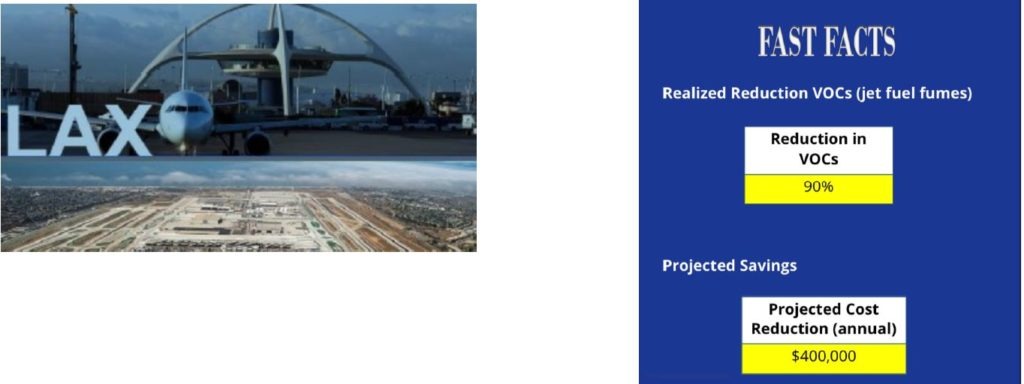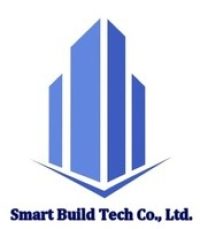
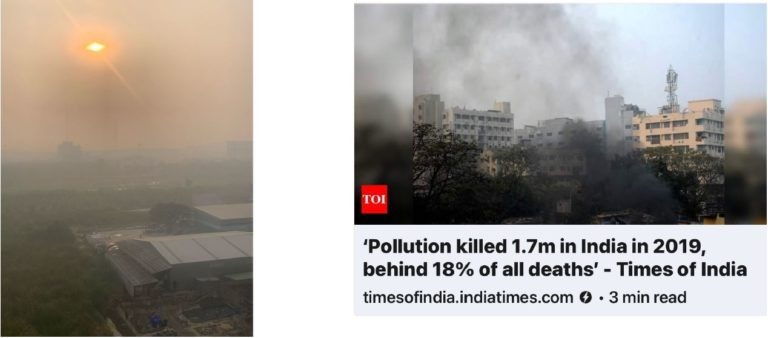
Our focus during these months will be no doubt related Covid-19 and the impossible air pollution PM2.5 numbers in some of our cities including Bangkok.
In business and in our buildings we predominantly feel safe from the outside world with the exception of COVID-19 which requires us to either work from home or wear masks. However our indoor Air quality is generally 2-5 times worse than outside air, we just cannot see the issue like we can outside. Current outside air quality is rated as unhealthy to hazardous, but consider that according to the US EPA we spend 90% of our time indoors and our buildings are designed to inhale this pollution in high volumes as “Fresh Air” making our indoor air quality worse than outside air.
(https://www.epa.gov/report-environment/indoor-air-quality).
What’s worse, is that during pandemics, we have been advised to increase outside air ventilation to reduce the Covid risk but increase our Indoor Air pollution. In Asia, as per normal, none of the building owners have reacted to this advice either because the system wont let them or because it increases the costs of cooling substantially. These are the same building owners who invariably have not cleaned or maintained the systems for anything other than keeping us cool when there is an issue. Out of sight…out of mind.
Also consider that our Indoor air systems are not designed to remove PM2.5 pollution, bacteria, mould, allergens, VOC’s or virus such as Covid. The poor design of our systems recirculates and leaves these IAQ issues in our breathing zone. In effect we have created the perfect storm for IAQ which we often refer to as “Sick Buildings” with feelings of lethargy, high absenteeism and a loss of productivity. How much does this cost us?…. Joseph Allen of Harvard T.H. Chan School of Public Health Stated that good indoor air quality relates to a productivity of US office workers of approximately USD6500 Per year without considering the possibility of long term health issues including Cancer, Lung disease, Brain disease (Alzheimer’s, Parkinson’s) and multiple other inflictions including COVID-19.
In the past the building industry created Indoor Air Quality (IAQ) issues such as Lead Based Paint and Asbestosis. These resulted in legal disputes, fines, bankruptcy and wholesale changes to the building industry and we are fast reaching the same point again.
All this leads to a serious consideration. “Is my place of work causing harm to my staff, visitors, customers??” “Am I/my company legally exposed in the short term or long term should my staff acquire Covid19 or perhaps lung disease in the future? This was certainly the case for Asbestosis and Lead Poisoning.
Why is the industry sweeping this issue under the carpet. The simple answer is;
1/ There has been no law suits as yet and;
2/ Most purification systems have substantial additional operating costs placing our health as a direct cost to the operation of the building or business. This means building owners/ operators must weigh your health against their profits.
What can be done? How do you protect your staff, customers and visitors?
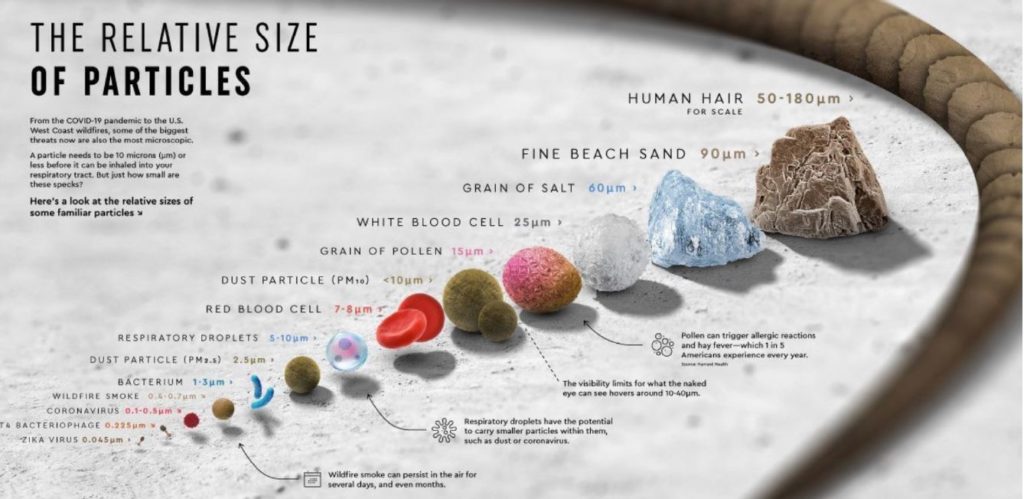
PASSIVE PURIFICATION SYSTEMS
We hear of a lot of MNC companies now taking directives at their regional offices to improve IAQ and protect staff from Covid-19/MERS/SARS etc.
Current advice for Covid Protection from the governing body for Heating, Ventilation and Air Conditioning suggests that we should reduce occupancy by half and increase ventilation by double. What does that mean for business? Is this actually the best solution or is this the most cautious advice reflecting legal advice? Should we or can we increase our office/schools/trains/ public spaces by double? Can we actually increase our ventilation? What about filtration, UV light, Air purifiers etc.? Is there a way to improve IAQ and make our facilities pandemic ready?
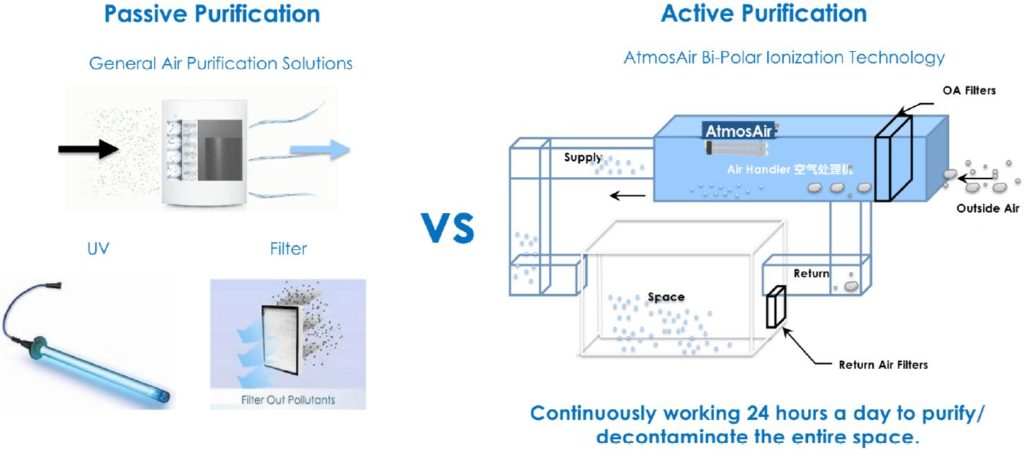
There are 2 possible solutions available; Passive Purification and Active Purification.
Passive Purification;
As an industry, the only tools we have had until recently were defined as Passive purification systems. Passive solutions are seldom implemented and of questionable effectiveness depending on how they are used/designed.
Increasing Ventilation – A simple solution but much easier said than done. 50% of the heat load of a building comes from outside air ventilation which relates directly to your energy bills. Increasing this by double will impact your energy bills substantially. Also consider that your system is not designed for this increased load meaning you will need to completely redesign the Air conditioning of your building. As a tenant this is impossible and as a building owner incredibly expensive and disruptive. Finally we must also deal with the fact that we are importing external air that is in many cities hazardous to provide increased safety from disease.
Filtration – You will find a level of filtration in all air conditioning systems. However the filter grade is essential in order to create some possible protection from pollution and disease. Most commonly Air conditioning systems are designed and operated with MERV6 – MERV7 filters. This results in the most energy efficient performance for the systems requiring smaller fans and less noise. As you will see in the figure below this is suitable for dust and some pollens. Approximately 15Microns. PM10 may penetrate these filters and PM2.5 and bacteria/virus will certainly pass cleanly through.
So what would we need to use in order to be completely safe? A HEPA filter is often suggested as an ideal solution and that which is used in operating theatres. HEPA filters also have a number of grades from MERV17- MERV20 but are generally found in indoor air purifiers. They are expensive consumable parts and require a huge air flow to pull the volume of air required through the system.
As an example we could insert a MERV20 filter into our office air conditioning system but the result will be what is called a pressure drop. Fans will no longer be able to cope with the load, no cooling or heating will be performed and the air conditioning will soon fail to operate. A system designed for MERV6 using these finer filters is much like placing a pillow over a vacuum cleaner inlet. A design change like this requires the entire Air Conditioning system to be redesigned for the power and noise that will be created. A complete replacement of the existing air conditioning system is required and the Operating costs will be substantially higher.
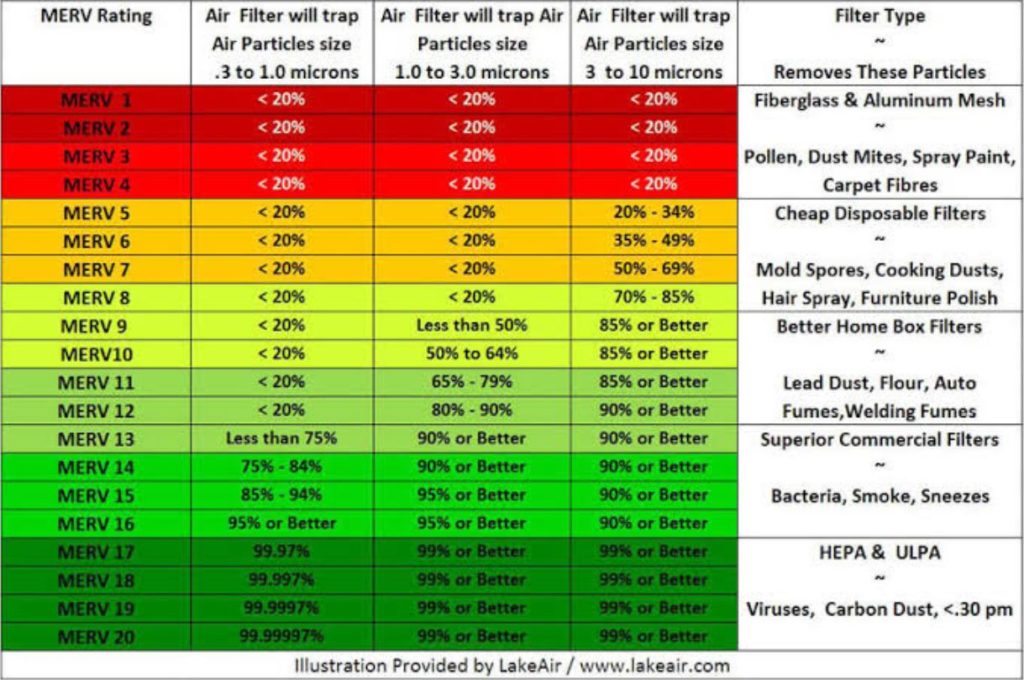
Indoor Air Purifiers – Whilst we see that most homes and many businesses have adopted this as a strategy, we see that the performance of these units don’t justify the price and they become ineffective in large spaces such as offices and public spaces. The reason is simple, the served area of the unit relates to the fan power in the unit and its ability to pull air through itself in order to increase safety.
The second reason is that these systems do not deal with many indoor pollutants or disease effectively. Odors and other pollutants that are not able to be caught in the filters require carbon filters and even then there are residual hazards that are still not treated. They are simple filters so any disease is encased in the filters to potentially multiply or be redistributed into the air. The figure below shows independent testing of the effectiveness of these systems in a scale defined as Clean Air Delivery Rate (CADR). An example here shows that the CADR of these systems is around 36 on the scale of effectiveness. Finally the cost of energy and the filters are high and require regular replacement adding to a substantial lifecycle cost.
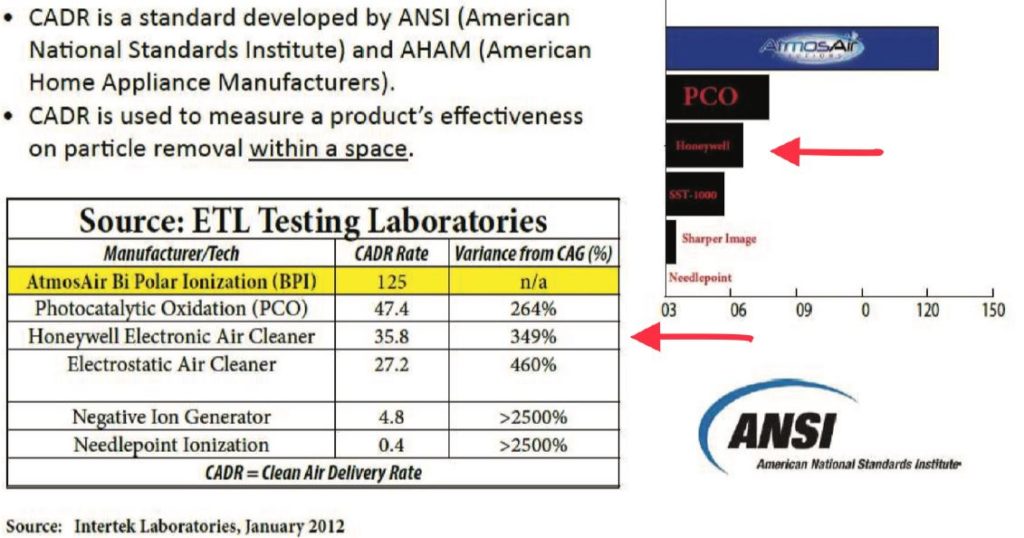
UV Sterilization Lights – It is common knowledge that UV lights can kill virus and bacteria. We have used them in Air conditioning systems for years but not for the purpose we assume. The issue is dwell time, that is the amount of exposure time to the UV light. We have used these systems for heat exchange coil sterilization. The coil is in the air flow and is often a breeding ground for mould and other microorganisms. The coil also doesn’t move like air so the exposed surfaces are constantly exposed. However a coil is designed with a huge amount of surface area which cannot be exposed to the UV light. This is the reason the system has not been successfully or widely used.
Secondly in todays pandemic we need to sanitize the air rather than the coil so the design of the system needs to sanitize rapidly moving air. Furthermore there is a lack of scientific evidence that shows that UVC light is effective on killing the Covid Virus. (https://www.fda.gov/medical-devices/ coronavirus-covid-19-and-medical-devices/uv-lights-and-lamps-ultraviolet-c-radiationdisinfection- and-coronavirus)

What can be done? How do you protect your staff, customers and visitors?
ACTIVE PURIFICATION SYSTEMS
There are 2 possible solutions available; Passive Purification and Active Purification. Active Purification;
Active Indoor Air purification systems have been very limited until comparatively recently. It is also a segment that has been wrought with false claims and limited science. These systems work within the space to actively purify the air and surfaces within the occupied space.
Most of the possible active purification systems to date have been those that require the space to be unoccupied such as Ozone or chemical fogging systems. These require Personal Protective suits as they are harmful to human health. The issue here being that we require protection from exhaled aerosol and pollutants whilst the space is occupied rather than after we leave for the day.

The next group of possible solutions launched were plasma ion and negative ion systems and ozone system in low concentrations.
All of these systems have seen considerable law suits, bankruptcy (e.g. Sharper Image in the USA) and strong warnings from the US EPA about the health hazards and ineffectiveness. (https:// www.epa.gov/indoor-air-quality-iaq/ozone-generators-are-sold-air-cleaners).
Still many of these systems have sold well during Covid to the unsuspecting or gullible purchasing teams or consumers. Claims like the ones in the photo below that Ozone is healthy and reverts to healthy oxygen fly in the face of all scientific evidence and government recommendations. Ozone is indeed a listed pollutant and irritant causing capuchins and lung pain. Indeed most electrical items today require a UL certificate certifying that they do not produce Ozone for our safety.
Indoor air quality and Ion sensors are now more common place and tests from consumers and customers have now resulted in considerable legal trouble as these systems have been shown to be ineffective scams.
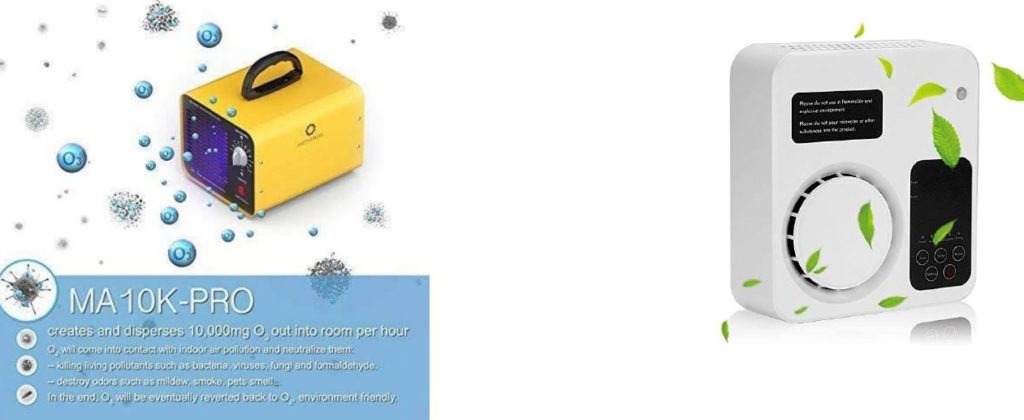
The most credible system to hit the market originated in the USA and has been used in over 100 Million Sq Ft of space. The system uses Bipolar ionization of Oxygen. This is a very natural phenomenon. Whilst we cannot see these ions they can be measured and we recognize them usually by association of the fresh air smell after a heavy rain fall. These ions are natures own purification system and are effective on most indoor air pollutants, odors, microorganisms and virus.
The system is made by US Company “Clean Air Group” trading as “AtmosAir Solutions”. AtmosAir Solutions is the leading manufacturer of air purification systems using bipolar ionization. AtmosAir’s patented bipolar ionization technology has been rigorously tested and scientifically proven to be among the most effective solutions for comprehensive air purification of indoor environments.
Unlike most air purification systems, AtmosAir doesn’t wait for pollutants to find their way into a filter via the return air of the HVAC system or another air cleaning device. Instead, charged ions actively seek out and neutralize contaminants at their source throughout your indoor environment, mimicking the way nature cleanses the air outdoors.
The Result – AtmosAir removes inhalable particles and pathogens – including dust, allergens, molds, VOCs, odors, airborne and surface bacteria, viruses and germs – to create healthy indoor environments where people thrive, while doing it efficiently and cost effectively.
The system is shown to be 99.92% effective on the Covid Virus as tested by MicroChem Laboratories.
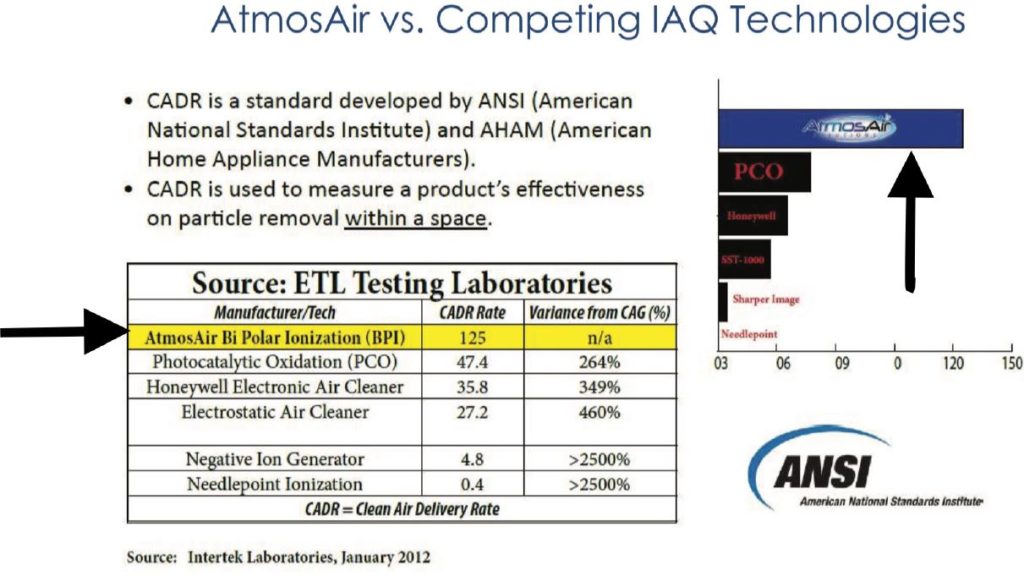

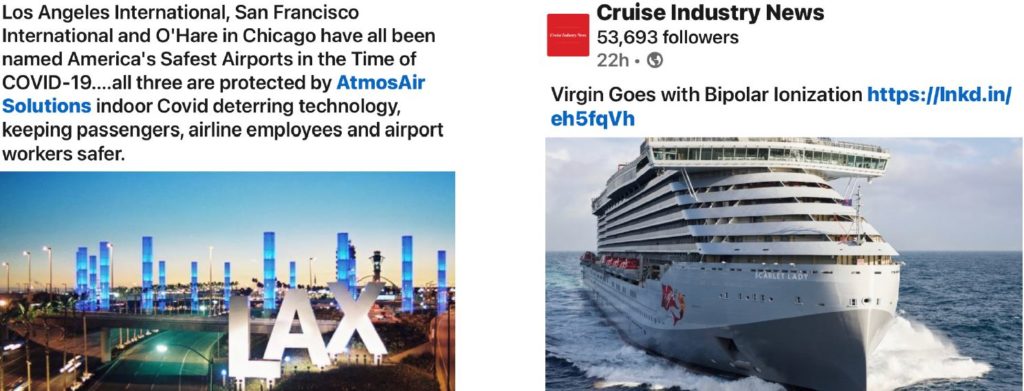

ASHRAE 62.1 Indoor Air Quality Procedure
Apart from the significant health benefits created by such an active system purification system as AtmosAir and obvious need to install these systems during times of pandemic, these systems provide an opportunity to vary the design of our air conditioning systems using ASHRAE 62.1 Indoor Air Quality Procedure (IAQP)
Unlike the conventional design methods, IAQP allows us to design a building with reduced ventilation which reduced the Heat load significantly. This reduction relates immediately to the reduction of HVAC heating and cooling costs.
Capital reduction of approximately 15% of HVAC equipment for new sites and 30% energy savings on both new and existing buildings means that rather than adding to the costs of operation such as passive systems, Active systems can save substantial operating costs and actually have a return on investment.
